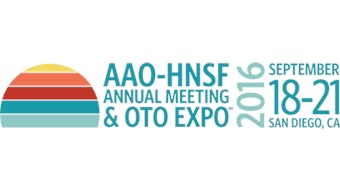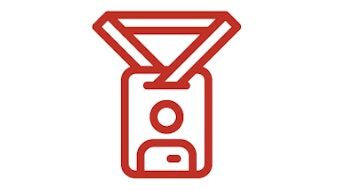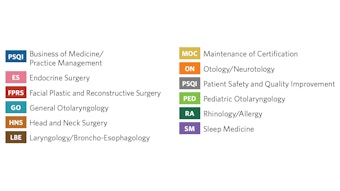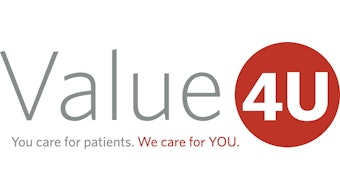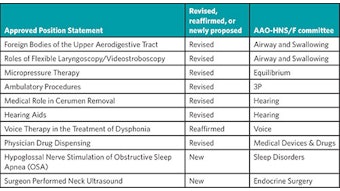Advocacy acronyms and committees
Below are key committees and acronyms you need to know to be an effective advocate for the specialty.
Below are key committees and acronyms you need to know to be an effective advocate for the specialty.
Capitol Hill powerhouses
HELP: U.S. Senate Committee on Health, Education, Labor, and Pensions. The committee has jurisdiction over multiple legislative issues, including some healthcare proposals.
E&C: U.S. House Committee on Energy and Commerce. The committee has principal jurisdiction over healthcare issues and related agencies, including the Department of Health and Human Services (HHS) and the Centers for Medicare & Medicaid Services (CMS).
Finance: U.S. Senate Committee on Finance. The committee has principal jurisdiction over matters relating to taxation and funding for programs such as Medicare and Medicaid.
W&M: U.S. House Committee on Ways and Means. The committee is the chief tax-writing committee in the U.S. House of Representatives, with jurisdiction over all taxation, tariffs, Social Security, unemployment benefits, Medicare, and welfare programs.
Coalition concoction
CHHC: Congressional Hearing Health Caucus. CHHC is a bipartisan caucus of members from the U.S. House and Senate committed to supporting the needs of people with hearing loss and other auditory disorders. The AAO-HNS is a member of the Friends of the CHHC.
DHHA: Deaf and Hard of Hearing Alliance. DHHA is a coalition that seeks changes to federal public policy to help improve the quality of life for people who are deaf, hard of hearing, or have hearing loss. The AAO-HNS is a member of the DHHA.
HCLA: Health Coalition on Liability and Access. HCLA is a national advocacy coalition working to advance medical liability reform at the federal level. The AAO-HNS serves on the HCLA Board.
PARTNERS: Tobacco control coalition led by the Campaign for Tobacco Free Kids. The AAO-HNS is a member of this coalition effort.
Who’s who in government
CBO: Congressional Budget Office. CBO produces independent analyses of budgetary and economic issues to support the Congressional budget process. CBO “scores” proposed bills to help lawmakers understand the cost or savings associated with a legislative proposal.
CMS: Centers for Medicare & Medicaid Services. CMS is a federal agency within the U.S. Department of Health and Human Services (HHS). It is responsible for administrating the Medicare program and working with states on administrating their Medicaid programs.
IPAB: Independent Payment Advisory Board. The IPAB is an unelected government body established under the Affordable Care Act (ACA, see below). It is charged with the responsibility for reducing the rate of growth in Medicare without affecting coverage or quality. At this time, no nominees have been nominated or appointed to the IPAB. The AAO-HNS supports repeal of the IPAB.
MedPAC: Medicare Payment Advisory Commission. MedPAC is an independent federal body established by the Balanced Budget Act of 1997. It is responsible for advising Congress on topics within the Medicare program, and more specifically, on issues dealing with payments to private health plans participating in Medicare and health providers that serve Medicare beneficiaries.
And other alphabet soup
ACA: Affordable Care Act. ACA is the healthcare reform law established in 2010. Some refer to the law as Obamacare.
ACO: Accountable Care Organizations. Groups of doctors, hospitals, and other healthcare providers, who come together to provide coordinated high quality care to their Medicare patients. Medicare offers several ACO programs: Medicare Shared Savings Program, Advance Payment ACO Model, and Pioneer ACO Model.
APM: Alternative Payment Model. Blanket term given to new payment models made for reimbursing healthcare providers. HHS has set a goal of tying 30 percent of Medicare fee-for-service payments to quality or value through APMs by 2016 and 50 percent by 2018.
CR: Continuing Resolution. A resolution made by Congress to continue funding for a program if the fiscal year ends without a new appropriation in place.
EHR: Electronic Health Records. Systemized collection of patient information in an electronically stored format. Ideally, these records can be shared across different settings and with other healthcare networks.
HIT: Health Information Technology. Software and computer systems to make medical records electronic, reducing paperwork and redundant forms. Federal and state governments are implementing policies to encourage the adoption of HIT while promoting quality initiatives and protecting patient privacy.
MIPS: Merit-Based Incentive Payment System. Beginning in 2018, the MIPS establishes a streamlined and improved incentive payment program that would focus the fee-for-service system on providing value and quality. The program would consolidate the three existing incentive programs, continuing the focus on quality, resource use, and meaningful EHR use with which professionals are familiar, but in a cohesive program that avoids redundancies.
MLR: Medical Liability Reform. MLR is a critical healthcare reform issue in the United States and a legislative priority for the AAO-HNS. Proponents of MLR are working to implement or amend legislation to reduce or cap excessive liability insurance costs for physicians while ensuring fair compensation for patients injured by negligent actions.
MU: Meaningful Use. CMS program that awards incentives for using certified EHRs to improve patient care. To achieve MU and avoid penalties, healthcare providers must meet certain thresholds and reporting requirements.
PAC: Political Action Committee. PACs allow individuals with shared interests the opportunity to pool their voluntary donations to make contributions to federal candidates on behalf of the entire group. PACs represent a legal and ethical way to participate in the election process. ENT PAC (www.entpac.org) is the political action committee of the AAO-HNS.
TIA: Truth in Advertising. The AAO-HNS and others in the physician community support state and federal efforts to implement TIA legislation requiring all healthcare providers to inform patients of their credentials and/or level of training in patient communications and marketing materials.
